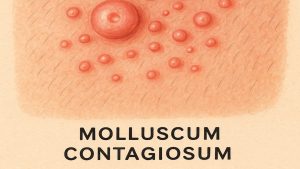- Clindamycin treats acne and bacterial infections effectively
- It stops bacteria by blocking protein synthesis
- Combining with benzoyl peroxide boosts acne results
- Side effects are mild but need monitoring
- Avoid long-term use without medical supervision
Clindamycin is an antibiotic used for bacterial infections including acne.
This guide explains what it is, how it works, who it suits, how to use it safely, and when to seek professional advice.

What Is Clindamycin
Clindamycin is a lincosamide antibiotic that targets anaerobic bacteria. It treats skin, respiratory, dental, and bone infections, especially when penicillin is unsuitable. In skincare, topical clindamycin targets Cutibacterium acnes to reduce inflammation and support clearer skin [1,3].
Historical Background
Clindamycin was derived from lincomycin in 1966 and became a valuable option for resistant infections. By the 1970s it entered dermatology as a topical acne treatment. Ongoing use reflects consistent clinical utility [1].
How Clindamycin Works
Clindamycin binds to bacterial ribosomes to block protein synthesis. This prevents bacterial growth and allows the immune system to clear infection more efficiently. Its tissue penetration supports treatment of both surface and deeper infections [2].
Supporting The Immune System
By lowering bacterial load, clindamycin helps reduce inflammation and immune strain. This dual action benefits difficult infections such as osteomyelitis when clinically indicated [6].
Common Uses Of Clindamycin
Clindamycin may be prescribed for cellulitis, pneumonia, bone infections, and dental abscesses. In dermatology, topical clindamycin is used for acne where it targets C. acnes and helps calm inflamed lesions [1,3,6].
Clindamycin & Acne Treatment
Topical clindamycin reduces C. acnes and visible inflammation. Combination with benzoyl peroxide is commonly recommended to enhance antibacterial action and lower resistance risk. Studies show meaningful lesion reduction after 12 weeks of consistent use [3,7].
A double blind trial found topical clindamycin comparable to oral minocycline for improving acne severity with a favourable safety profile [4]. A prescriber can advise on suitability based on your skin and medical history.
Other Dermatological Uses
Topical clindamycin may help folliculitis and boils by reducing bacterial growth and swelling. Evidence for rosacea remains limited and is not conclusive at this time [6].
Key Benefits Of Clindamycin
| Benefit | Description |
|---|---|
| Broad spectrum | Targets a range of relevant bacteria |
| Deep tissue reach | Penetrates skin, joints, and bone tissues |
| Resistance backup | Option when other antibiotics are unsuitable |
| Acne reduction | Lowers bacteria and inflammation in acne |
Table 1: Summary of antibacterial coverage and acne related benefits
Using Clindamycin Safely
Correct use supports results and helps limit resistance development [9]. Formulation and route depend on indication. Oral capsules are used for systemic infections. Topical formulations are used for acne.
Intravenous use is reserved for severe infections in clinical settings [9]. For oral forms, swallow with a full glass of water to reduce throat irritation and complete the full prescribed course. Store as directed on the label [10].
Practical Tips
- Cleanse and dry skin before applying topical clindamycin
- Apply a thin layer to affected areas twice daily unless advised otherwise
- Expect results within 6 to 12 weeks with consistent use [3,7]
- Pair with benzoyl peroxide when recommended to reduce resistance risk
- Avoid other topical antibiotics unless your prescriber agrees
- Use non comedogenic moisturiser and daily sunscreen to support skin barrier
Clindamycin Side Effects
Most people tolerate clindamycin. Possible effects include mild nausea or diarrhoea. Topical use may cause temporary redness or dryness. A rare but serious risk is Clostridioides difficile associated diarrhoea, mainly with oral use.
Seek medical help for severe, persistent, or bloody diarrhoea, abdominal pain, or signs of dehydration [11,13].
| Side effect | Frequency | Management tip |
|---|---|---|
| Nausea or diarrhoea | Around 10 percent | Take with food if suitable |
| C. difficile infection | Around 1 to 2 percent | Urgent care if diarrhoea persists |
| Skin irritation | Less than 0.1 percent | Stop use and seek advice if rash develops |
Table 2: Common reactions and when to seek help
Alternatives & Precautions
If allergy or adverse effects occur, alternatives may include doxycycline or metronidazole depending on the condition and clinical judgement [14]. People with gastrointestinal disease or liver issues should use clindamycin with medical supervision.
Share all medicines with your prescriber since interactions can occur, including with neuromuscular blockers [11]. Topical therapy generally carries lower systemic risk than oral therapy but still requires monitoring.
Long Term Use Insights
Extended antibiotic use may increase resistance risk and alter gut flora [5,13]. Overuse of topical clindamycin can promote resistant C. acnes strains [13]. Regular reviews, time limited courses, and combination strategies such as adding benzoyl peroxide can help maintain effectiveness.
Does Clindamycin Really Work
Evidence and clinical experience show clindamycin can be effective for acne and bacterial infections when used correctly. Outcomes depend on adherence, correct formulation, duration, and professional oversight. No treatment suits everyone. Your clinician will guide personalised choices.
Monderma’s Personalised Skincare Approach
Monderma offers prescription skincare for acne. Formulas may include clindamycin, tretinoin, or adapalene where clinically appropriate. A GPhC registered professional reviews your health information and may design a personalised plan to balance efficacy with safety.
Conclusion
Clindamycin is a well-established antibiotic that helps treat acne and other bacterial infections by limiting bacterial growth and calming inflammation.
For safe, effective use, explore Monderma’s free consultation to receive support on possible formulas and direction.
Content is for informational purposes only. Monderma treatments are prescribed following consultation. Results and timeframes can vary. Use as directed by your prescriber.
Bibliography
- American Chemical Society. Clindamycin. 2022.
- Spížek J, Řezanka T. Lincosamides: Mechanism of Action & Applications. Biochem Pharmacol. 2017.
- Gold MH et al. Clindamycin Phosphate 1.2% & Benzoyl Peroxide 2.5% Review. J Clin Aesthet Dermatol. 2012.
- Sheehan-Dare RA, et al. Topical Clindamycin vs Oral Minocycline in Acne. Acta Derm Venereol. 1990.
- Simpson NB. Antibiotics in Acne: Time for a Rethink. Br J Dermatol. 2001.
- Brown NM et al. Treatment of MRSA Infections. JAC-AMR. 2021.
- MedlinePlus. Clindamycin. Updated 2024.
- Drugs.com. Clindamycin Patient Tips. 2023.
- WebMD. Clindamycin (Cleocin) Overview. 2024.
- AJMC. C. difficile Risk with Clindamycin & Antibiotics. 2023.
- DrugBank Online. Clindamycin Interactions. 2021.
- European Lessons on Antibiotic-Resistant Acne. Br J Dermatol. 2003.
- Frontiers in Microbiology. Antibiotic Resistance in Cutibacterium acnes. 2025.
- Murphy PB, Bistas KG, Patel P. Clindamycin. StatPearls. 2024.
Find your perfect skincare formula
Takes less than 2 minutes – see what your skin needs
Get Custom Formula













